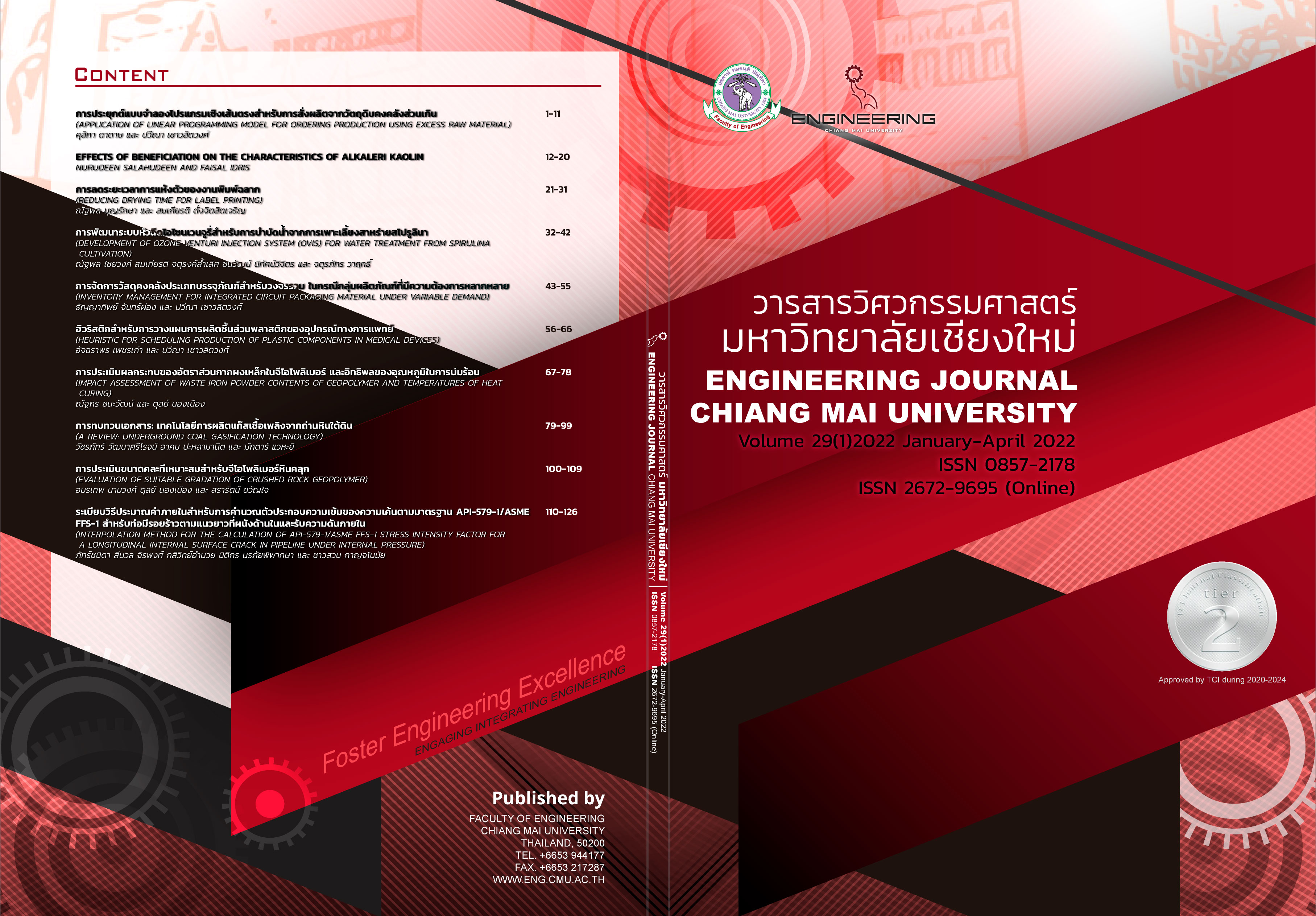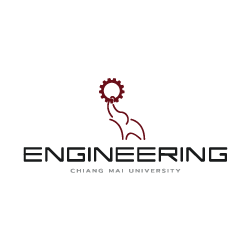การประเมินผลกระทบของอัตราส่วนกากผงเหล็กในจีโอโพลิเมอร์ และอิทธิพลของอุณหภูมิในการบ่มร้อน
คำสำคัญ:
จีโอโพลิเมอร์, กากผงเหล็ก, เถ้าลอย, กำลังรับแรงอัด, กำลังรับแรงดัดบทคัดย่อ
การประเมินผลกระทบของอัตราส่วนกากผงเหล็กในจีโอโพลิเมอร์จากเถ้าลอยแม่เมาะและอิทธิพลของอุณหภูมิในการบ่มร้อน ซึ่งควบคุมสารละลายด่างโดยใช้ความเข้มข้นสารละลายโซเดียมไฮดรอกไซด์ที่ 8 โมลาร์ อัตราส่วนสารละลายโซเดียมไฮดรอกไซด์ต่อโซเดียมซิลิเกต (SS/SH) เท่ากับ 1.0 อัตราส่วนของเหลวต่อวัสดุประสานโดยน้ำหนัก (L/B) เท่ากับ 0.45 ในงานวิจัยกำหนดตัวอย่างจีโอโพลิเมอร์เถ้าลอยเป็นเป็นตัวควบคุม (Controlled geopolymer, CGP) โดยเปรียบเทียบกับการประเมินผลของจีโอโพลิเมอร์ผสมกากผงเหล็กที่อัตราส่วนกากผงเหล็กร้อยละ 5, 10, 15 และ 20 โดยน้ำหนักเถ้าลอยบ่มร้อนที่อุณหภูมิ 60 องศาเซลเซียสเป็นเวลา 24 ชั่วโมง และในส่วนการประเมินอิทธิพลของอุณหภูมิที่อัตราส่วนกากผงเหล็ก ร้อยละ 20 โดยนำไปบ่มร้อนที่ 30, 40, 50 และ 60 องศาเซลเซียส เป็นเวลา 24 ชั่วโมง แล้วพิจารณาผลของอัตราส่วนกากผงเหล็กและอิทธิพลของอุณหภูมิที่มีผลต่อสมบัติเชิงกายภาพ ได้แก่ ระยะเวลาก่อตัว ความหนาแน่นรวม และสมบัติเชิงกล ได้แก่ กำลังรับแรงอัด และกำลังรับแรงดัด ของตัวอย่างอายุ 3, 7 และ 28 วัน ผลการศึกษาพบว่า ระยะเวลาก่อตัวจะลดลงเมื่ออัตราส่วนกากผงเหล็กเพิ่มขึ้น ในส่วนของความหนาแน่นรวมของตัวอย่างจีโอโพลิเมอร์ที่ผสมกากผงเหล็กพบว่า ความหนาแน่นรวมเพิ่มขึ้นตามอัตราส่วนของกากผงเหล็ก ซึ่งตัวอย่างที่มีความหนาแน่นรวมที่สูงขึ้นส่งผลทำให้มีกำลังมากกว่าตัวอย่างที่มีความหนาแน่นรวมน้อย ทั้งนี้เมื่อเทียบกับตัวอย่างจีโอโพลิเมอร์ควบคุม พบว่ากำลังรับแรงอัดมีค่าลดลง ในขณะที่กำลังรับแรงดัดมีค่าสูงขึ้น กำลังของจีโอโพลิเมอร์จะลดลงตามอายุของจีโอโพลิเมอร์มากขึ้น และอุณหูมิบ่มที่สูงขึ้น จากการศึกษาอุณหภูมิบ่มร้อนที่เหมาะสมต่อจีโอโพลิเมอร์ในการศึกษา คือช่วง 50-60 องศาเซลเซียส การพัฒนากำลังรับแรงอัดและแรงดัดมีแนวโน้มเพิ่มขึ้นตามอุณหภูมิการบ่ม จนถึงช่วงอุณหภูมิที่เหมาะสมกำลังของจีโอโพลิเมอร์ผสมกากผงเหล็กให้ค่าสูงสุด เมื่ออุณหภูมิมากกว่าช่วงที่เหมาะสม กำลังรับแรงอัดและแรงดัดมีแนวโน้มลดลง
เอกสารอ้างอิง
การไฟฟ้าฝ่ายผลิตแห่งประเทศไทย แม่เมาะ, “การนำเถ้าลอยลิกไนต์ไปใช้ประโยชน์,” maemoh.egat.com, Nov. 17, 2016. [Online]. Available: http://maemoh.egat.com/. [Accessed Mar. 2, 2020].
ศูนย์ข้อมูลเชิงลึกอุตสาหกรรมเหล็กไทย, “การศึกษาสถานภาพอุตสาหกรรมเศษเหล็ก ภายใต้โครงการพัฒนาศูนย์ข้อมูลเชิงลึกอุตสาหกรรมเหล็กและโลหการ”. Sep. 01, 2015. [Online]. Available: http://iiu.isit.or.th/th/reports/In-Depth%20Research%20Report.aspx [Accessed Mar. 2,2020].
อุบลลักษณ์ รัตนศักดิ์, วัสดุจีโอโพลิเมอร์. กรุงเทพฯ: สมาคมคอนกรีตแห่งประเทศไทย, 2560.
A. M. M. Al Bakria, H. Kamarudin, M. BinHussain, I. K. Nizar, Y. Zarina, and A. R. Rafiza, “The effect of curing temperature on physical and chemical properties of geopolymers,” Physics Procedia, vol. 22, pp. 286–291, 2011.
K. Neupane, “Fly ash and GGBFS based powder-activated geopolymer binders: A viable sustainable alternative of portland cement in concrete industry,” Mechanics of Materials, vol. 103, Dec., pp. 110–122, 2016.
A. A. Adam, and X. X. X. Horianto, “The effect of temperature and duration of curing on the strength of fly ash based geopolymer mortar,” Procedia Engineering, vol. 95, pp. 410–414, 2014.
P. Chindaprasirt, T. Chareerat, and V. Sirivivatnanon, “Workability and strength of coarse high calcium fly ash geopolymer,” Cement and Concrete Composites, vol. 29, no. 3, pp. 224–229, 2007.
American Society for Testing and Materials, “ASTM C618: Standard Specification for Coal Fly Ash and Raw or Calcined Natural Pozzolan for Use in Concrete”. Feb. 11, 2019. [Online]. Available: https://www.astm.org/standards/c618. [Accessed Mar. 02, 2020].
American Society for Testing and Materials, “ASTM C191: Standard Test Method for Time of Setting of Hydraulic Cement by Vicat Needle”. Nov. 05, 2021. [Online]. Available: https://www.astm.org/standards/c191. [Accessed Mar. 02, 2020].
British Standards Institution, “BS EN 196-1: Methods of testing cement - Part 1: Determination of strength”. May. 31, 2016. [Online]. Available: https://landingpage.bsigroup.com/LandingPage/Undated?UPI=000000000000483082. [Accessed Mar. 02, 2020].
ดาวน์โหลด
เผยแพร่แล้ว
ฉบับ
ประเภทบทความ
สัญญาอนุญาต
ลิขสิทธิ์ของบทความที่ตีพิมพ์ในวารสารฉบับนี้จะยังเป็นของผู้แต่งและยินยอมให้สิทธิ์เผยแพร่กับทางวารสาร
การเผยแพร่ในระบบวารสารแบบเปิดนี้ บทความจะสามารถนำไปใช้ได้ฟรีในการศึกษา และในทางที่ไม่เกี่ยวกับการค้า




